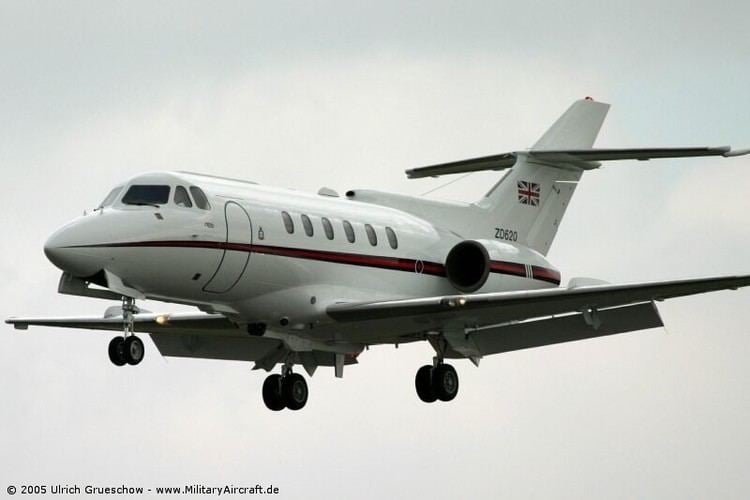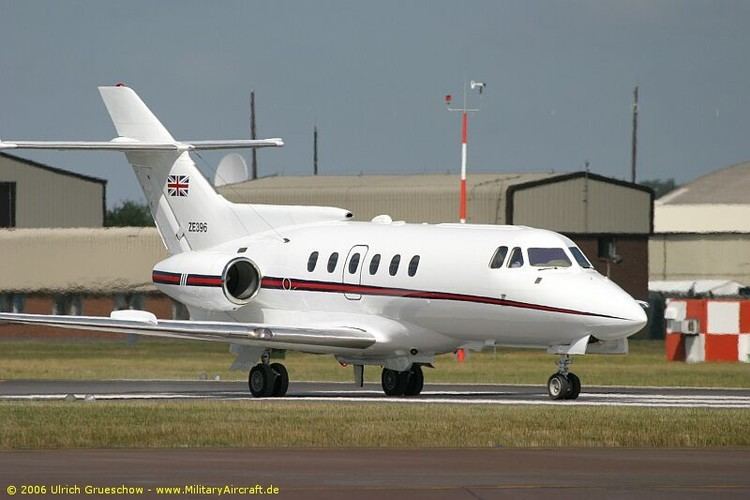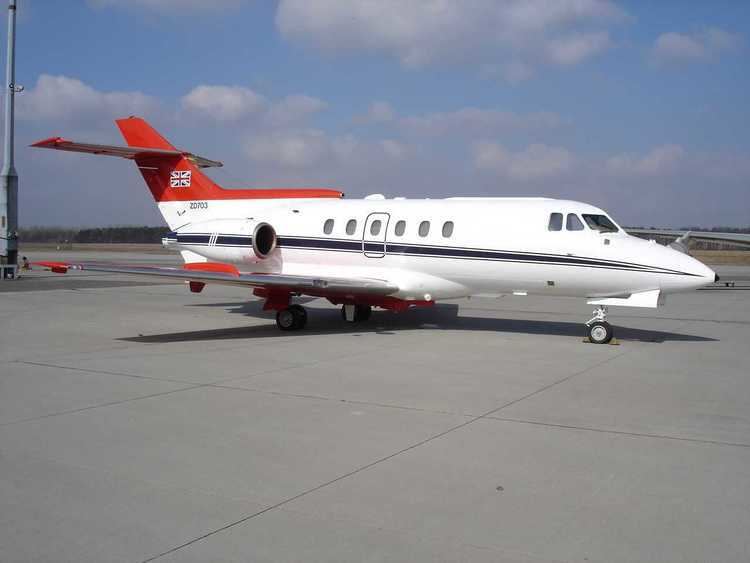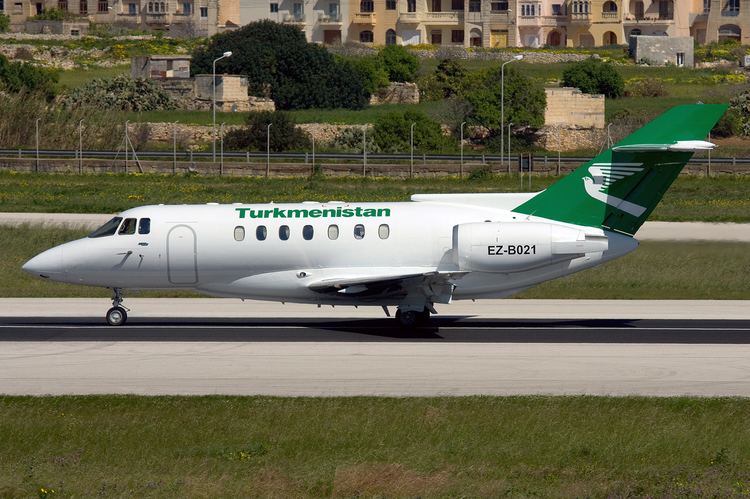Wingspan 14 m Engine type Turbofan | Length 15 m | |
 | ||
Manufacturers | ||
British aerospace 125
The British Aerospace 125 is a twin-engine mid-size corporate jet. Originally developed by de Havilland and initially designated as the DH125 Jet Dragon, it entered production as the Hawker Siddeley HS.125, which was the designation used until 1977. Later on, more recent variants of the type were marketed as the Hawker 800.
Contents
- British aerospace 125
- Origins
- Production
- Design
- Operational history
- Variants
- Civil operators
- Military operators
- Accidents and incidents
- Aircraft on display
- Specifications HS 125 Series 600
- References

The type proved quite popular overseas; more than 60% of the total sales for the aircraft were to North American customers. It was also used by the Royal Air Force as a navigation trainer, as the Hawker Siddeley Dominie T1, and was operated by the United States Air Force as a calibration aircraft, under the designation C-29.

Origins

In 1961, de Havilland began work upon a small business jet, then known as the DH.125 Jet Dragon, which was intended to replace the piston engined de Havilland Dove, a successful business aircraft and light transport. Prior to the start of the project, de Havilland had determined that a successful business jet would require several variables to be met, including a range of at least 1,000 miles, the speed and cost factors of a suitable jet engine to outperform turboprop-propelled competitors, and an engineering philosophy that favored reliability and conventionality. The design team settled on a twin-engine aircraft with the engines mounted on the rear fuselage, the Bristol Siddeley Viper turbojet powerplant was also selected to power the type.

On 13 August 1962, the first of two prototypes conducted its first flight, a second aircraft followed it on 12 December that year. The second prototype was more aerodynamically-representative of a production aircraft, and was fitted out with more equipment than the first prototype; the subsequent production-standard aircraft incorporated several changes and improvements from the prototypes, such as a longer fuselage and a greater wingspan. The first production-standard aircraft performed its first flight on 12 February 1963. The first delivery to a customer took place on 10 September 1964.
Production

The aircraft went through many designation changes during its service life. Hawker Siddeley had bought de Havilland the year before the project had started, but the legacy brand and "DH" designation was used throughout development. After the jet achieved full production, the name was changed to "HS.125" except for American exports which retained the DH.125 until it was replaced by BH.125 for Beechcraft-Hawker. When Hawker Siddeley Aircraft merged with the British Aircraft Corporation to form British Aerospace in 1977, the name changed to BAe 125. When British Aerospace sold its Business Jets Division to Raytheon in 1993, the then-main variant of the jet became widely referred to as the Hawker 1000.

While the two prototypes were assembled at de Havilland's Hatfield site, final assembly of all production aircraft would take place at the Broughton factory near Chester until the 1990s. By the 2000s, the fuselage, wings and tailfin of the aircraft were still being assembled and partially equipped in the Broughton site, now being owned and managed by Airbus UK; various sub-assemblies were also produced in Airbus UK's Buckley facility. From 1996 onwards, the assembled sections and components were shipped to Wichita, Kansas in the United States, to undergo final assembly. Writing in 1993, Flying Magazine said of the type "In numerical terms, the 125 series is the most successful British commercial aircraft ever built, and the world's longest in-production business jet".
Production of the aircraft came to an abrupt halt in 2013 due to the bankruptcy of owner Hawker Beechcraft, who has suffered during the Great Recession of the late 2000s in which demand for business jets had slumped for a number of years. The type had been in production for more than 50 years when manufacturing stopped, during which time over 1,600 aircraft had been produced. In April 2013, the type certificate and support responsibility for all 125s built was transferred to the reformed Beechcraft Corporation. As of October 2012, Beechcraft does not intend to restart production of its business jet lines; instead the company intends to alternatively sell or dismantle the production facilities for the 125 family.
Design
The DH.125 is a low-winged monoplane, powered by two engines mounted on the rear fuselage. The wing is slightly swept, being based upon the larger de Havilland Comet's wing planform, and employs large slotted flaps and airbrakes to better enable operations from small airfields; the aircraft can be flown from hardened grass airstrips. The type has a perfectly cylindrical fuselage with the one-piece wing mounted upon the underside of the fuselage; this design allows for the majority of manufacturing and assembly work of the wing and fuselage to be performed as separate sections with the two being joined together late in the production process. The wing also houses integral fuel tanks which contain the majority of the aircraft's fuel.
Early models of the aircraft were powered by several versions of the Bristol Siddeley Viper turbojet engine, while later aircraft have adopted more recent turbofan powerplants such as the Garrett TFE731 and Pratt & Whitney Canada PW300. As well as providing the propelling thrust of the aircraft, each of the engines are connected to independent gearboxes which provide electrical power via generators and drive the onboard fuel, oil and hydraulic pumps and a generator for electrical power. The design is redundant so that in the event of a single engine failing, all aircraft systems shall continue to operate normally.
All control surfaces of the aircraft are aerodynamically balanced via set-back hinges and geared tabs. The flaps and airbrakes are operated using the aircraft's hydraulics, while the ailerons, elevators, and rudder are manually-actuated. The design of the control circuits allows for an Collins-built A.P.103 autopilot to be incorporated. Each aircraft is typically equipped with a de-icing system, which uses a mixture of bleed air from the engines, TKS fluid for general airframe, and AC electric windshield heating to prevent ice formation. From the type's introduction to service, weather radar was incorporated into the aircraft's avionics fit out. Some operators, such as the Royal Air Force, have equipped their 125s with electronic countermeasures to defend against hostile missile attacks upon the aircraft.
The pressurised fuselage was designed to accommodate two pilots and six passengers. Various interiors were offered for the aircraft, the standard interior offered a high degree of comfort to the passengers. In an executive configuration, the flight deck is separated from the main passenger cabin; the single entrance of the aircraft, located directly behind the cockpit and forward of the passenger cabin, forms a vestibule area in which luggage can be stored and meals prepared during flight. An unobstructed cabin floor with 5 ft 9in of headroom and a 3 ft wide cabin door also allowed the loading of bulky equipment, which was seen as particularly attractive to military operators. In addition to the entrance door, an emergency overwing exit hatch is also located in the passenger cabin midsection over the starboard wing (some versions have both port and starboard exits). The rear of the fuselage is occupied by a large equipment bay and, on some aircraft, two additional fuel tanks for extended operations.
Operational history
Having entered service as one of the first-generation executive jets, the British Aerospace 125 has been operated by a wide variety of customers, ranging from government and military operators to private customers and businesses, it has also seen use by several airlines. Many of the aircraft's customers have been located in North America; in 1990, out of the 650 aircraft then being operated, more than 400 were being flown in the United States. Reportedly, one aircraft was being sold every seven working days for a substantial period of the type's production life. Successively larger versions were introduced to extend the type's appeal and to better compete against larger jets being used for business travel, such as the Gulfstream IV and Falcon 900.
The Royal Air Force was a significant early operator of the type, receiving a number of aircraft for multiple roles, including some of the first batch of 30 aircraft to be produced. The majority of 125s were operated in an airborne training capacity for air force navigators, aircraft in this role were named as the Hawker Siddeley Dominie; the Dominie served in excess of 45 years before being retired in 2011 due to diminishing requirements. Additional 125s were acquired and operated by No. 32 Squadron RAF as communications and light transport aircraft; these are also occasionally operated to transport Queen Elizabeth II and other members of the British Royal Family. In the later stages of the War in Afghanistan, various 125s have been used to transport military officers and other key personnel in and out of the country. As of 2010, the type was scheduled to be withdrawn from RAF service in 2022. It was withdrawn from the RAF in 2015
By the early 1990s, British Aerospace, the manufacturer of the type at this point, had two main variants of the aircraft in production; the smaller 125-800 and larger 125-1000. The 125-1000, which conducted its first flight on 16 June 1990, had several changes to give the type a reported intercontinental range, including the adoption of the newly developed Pratt & Whitney Canada PW300 engine and new digital avionics, such as FADEC. Following Raytheon's purchase of British Aerospace's Business Jet Division during the 1990s, the two in-production variants were re-designated as the Hawker 800 and Hawker 1000 respectively.
The 125 has had the dubious distinction of being the only business jet to have ever been hijacked; in 1967, a chartered 125 carrying the former Congolese Prime Minister Moise Tshombe was diverted to Algeria by armed individuals on board. The 125 is also likely to have been the only business aircraft to have ever survived being hit by an air-to-air missile; in August 1988, a British Aerospace 125-800 transporting Botswanan President Quett Masire was struck by a missile which had apparently been inadvertently launched by a nearby Angolan Mikoyan-Gurevich MiG-21. While badly damaged by the direct hit, which resulted in the loss of an engine, the cabin decompressing, and fuel tanks being ruptured; the aircraft was successfully landed by BAe demonstrator pilot Arthur Ricketts, it was later rebuilt.
In 2013, the FAA modified 14 CFR part 91 rules to prohibit the operation of jets weighing 75,000 pounds or less that are not stage 3 noise compliant, specifically mentioning the 125 series of aircraft. This shall require any aircraft of the type to either have Stage 3 noise compliant engines installed or to be fitted with "hushkits", or otherwise will not be permitted to fly over the majority of the United States after 31 December 2015, unless special permission has been granted.
Variants
Civil operators
Private operators, air taxi, shared ownership and corporate charter operators worldwide. Between 1965 and 1972 Qantas used two Series 3s for crew training.
Numerous 125 aircraft have been privately owned, such as the BAe 125 800 that was owned by Ayrton Senna da Silva, a triple-World Champion of Formula One racing.
Military operators
Accidents and incidents
Aircraft on display
Specifications (HS 125 Series 600)
Data from Jane's All The World's Aircraft 1976–77, Flight International
General characteristics
Performance
